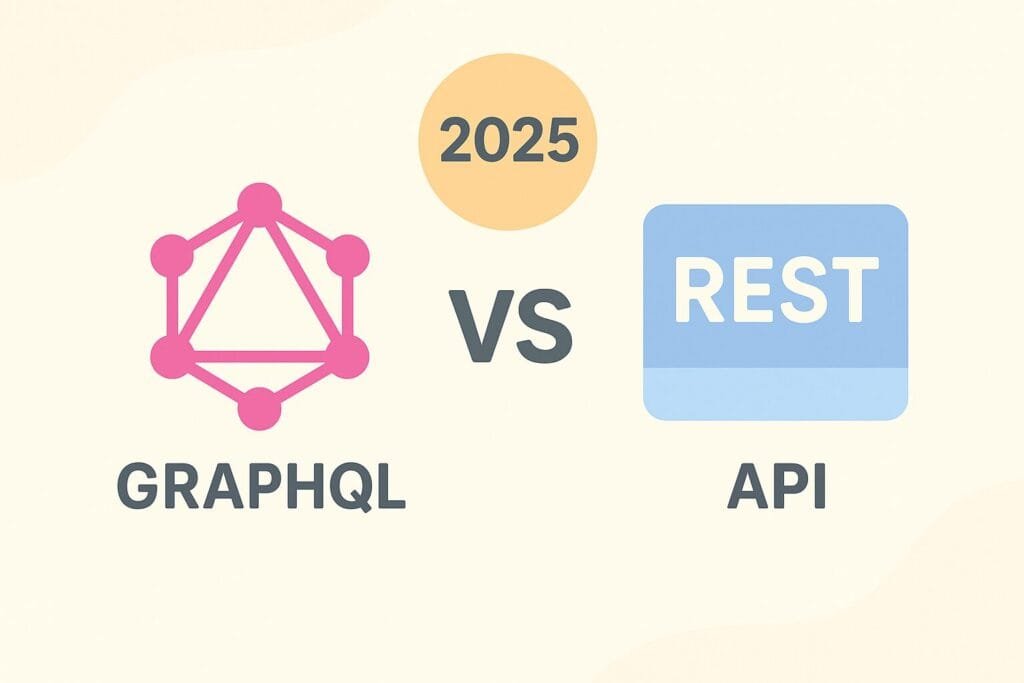As technology continues to evolve, the debate between GraphQL vs REST remains one of the most discussed topics among developers and API architects. Both have shaped how data is requested and served across the web, mobile, and backend systems. However, as we enter 2025, it’s essential to re-evaluate which API design style offers the best performance, flexibility, and developer experience in modern applications.

What is REST?
REST (Representational State Transfer) is an architectural style that relies on predefined HTTP methods like GET, POST, PUT, and DELETE to communicate between client and server. Each URL represents a resource, and RESTful APIs are known for their simplicity and compatibility with the web’s existing infrastructure.
REST APIs are stateless, meaning each request from the client must contain all necessary information to complete the operation. This design makes REST easy to cache and scale but can also lead to inefficiencies in data fetching, especially when multiple endpoints are required to build complex UI views.
What is GraphQL?
GraphQL was developed by Facebook (now Meta) in 2012 and released publicly in 2015. Unlike REST, GraphQL allows clients to request exactly the data they need—nothing more, nothing less. It operates through a single endpoint using queries and mutations to fetch and modify data.
In a GraphQL API, the structure of the request determines the structure of the response. This makes it highly flexible and efficient, especially for mobile and frontend developers who want to reduce over-fetching and under-fetching problems common in REST APIs.
GraphQL vs REST: A 2025 Comparison
| Feature | REST API | GraphQL API |
|---|---|---|
| Architecture | Multiple endpoints for different resources | Single endpoint for all data requests |
| Data Fetching | Fixed data per endpoint (may over-fetch) | Client controls data structure (no over-fetch) |
| Performance | Can be slower due to multiple requests | Optimized with a single query |
| Caching | Easy with HTTP caching | Requires custom caching layer |
| Error Handling | Standard HTTP status codes | Returned inside the GraphQL response |
| Learning Curve | Simple for beginners | Steeper due to schema and query language |
| Tooling & Ecosystem | Mature and widely supported | Rapidly growing with modern tools |
| Use Case | Best for simple CRUD APIs | Best for complex, data-rich applications |
Advantages of Using GraphQL in 2025
- Efficiency: Only fetch the exact fields needed, improving performance on slow networks.
- Single Endpoint: Simplifies API management and development workflows.
- Strong Typing: GraphQL schemas define data types and ensure predictable results.
- Better Developer Experience: Tools like GraphiQL and Apollo Studio make query testing easier.
- Future-Proof: As applications become more data-driven, GraphQL scales easily with evolving frontend needs.
Advantages of REST in 2025
- Simplicity: REST APIs remain straightforward and easy to implement.
- Native Caching: Built-in HTTP caching improves speed and scalability.
- Compatibility: Works well with browsers, servers, and traditional infrastructure.
- Mature Ecosystem: Years of community support and documentation.
- Security: HTTP standards provide stable and proven security models.
Performance Benchmark in 2025
Recent performance tests show that GraphQL can outperform REST when it comes to reducing network payload size and request count. However, REST may still be faster in scenarios where caching and CDN are heavily optimized. Therefore, the performance advantage largely depends on the use case and implementation quality.
When Should You Choose GraphQL?
GraphQL is ideal for projects that:
- Require dynamic data fetching from multiple sources
- Serve data-heavy frontends like mobile apps or dashboards
- Need rapid iteration and scalability
- Involve microservices and distributed data layers
When Should You Choose REST?
REST is still a great choice if your project:
- Has simple data models and CRUD operations
- Needs straightforward caching and low server overhead
- Involves legacy systems or traditional backends
- Does not require complex client-side data querying
Real-World Adoption in 2025
In 2025, companies like Shopify, GitHub, and Netflix continue to use GraphQL for performance and flexibility, while many enterprise-level APIs still rely on REST due to its stability and wide compatibility. According to developer surveys, nearly 40% of backend developers now include GraphQL in their stack, compared to just 10% in 2018 — showing steady growth and adoption.
SEO and Data APIs
While REST and GraphQL do not directly influence SEO, the speed and reliability of APIs can indirectly improve web performance scores, which affect search rankings. GraphQL, when optimized properly, can contribute to faster data delivery and better Core Web Vitals.
External Resource
To learn more about API trends and developer surveys, check out the official State of API Report 2024.
Conclusion
Both GraphQL and REST remain powerful technologies for building APIs. In 2025, the choice depends on your project’s complexity, performance requirements, and developer expertise. If you need speed, flexibility, and a future-proof architecture, GraphQL is the better option. However, if you value simplicity, stability, and compatibility, REST continues to deliver excellent results.
Ultimately, many companies now combine both approaches — using REST for simple endpoints and GraphQL for complex queries — to get the best of both worlds.

